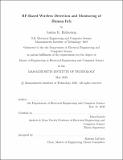| dc.contributor.advisor | Dina Katabi. | en_US |
| dc.contributor.author | Hellerstein, Joshua K. | en_US |
| dc.contributor.other | Massachusetts Institute of Technology. Department of Electrical Engineering and Computer Science. | en_US |
| dc.date.accessioned | 2020-09-15T21:56:15Z | |
| dc.date.available | 2020-09-15T21:56:15Z | |
| dc.date.copyright | 2020 | en_US |
| dc.date.issued | 2020 | en_US |
| dc.identifier.uri | https://hdl.handle.net/1721.1/127405 | |
| dc.description | Thesis: M. Eng., Massachusetts Institute of Technology, Department of Electrical Engineering and Computer Science, May, 2020 | en_US |
| dc.description | Cataloged from the official PDF of thesis. | en_US |
| dc.description | Includes bibliographical references (pages 109-111). | en_US |
| dc.description.abstract | Chronic pruritus or itch, defined as itch lasting greater than 6 weeks, is a feature of many skin disorders affecting millions of people around the world. Excessive itch is highly correlated with anxiety and depression, greatly affecting a person's quality of life - yet there is no widely accepted way to objectively measure itch. Previous works involving indoor Radio Frequency (RF, RADAR) wireless monitoring show the possibility of using such contactless technology to monitor nocturnal scratching activity. Scratching activity has the potential to be used as an objective measure of itch. This work presents a robust IoT data collection system for continuously ingesting, processing, labeling, and analyzing multi-modal medical data. It monitors the scratching activity of chronic pruritus patients in-the-wild. We deploy the system to chronic pruritus patients for 4 weeks to collect data, and prototype a model which estimates scratching duration from the RF device alone. It paves the way for future work on developing deep learning models which automatically detect scratching from real patient data. In a preliminary analysis of the relationship between scratching activity (observed with an infrared camera) and perceived itch (NRS itch score), we found that scratching has a positive correlation with self-reported NRS itch scores on a per-night basis (R ~/~ 0.5, P < 0.05) and on a per-patient basis (R = 0.72, P = 0.17). These results show self-reporting of itch is still subjective, and doesn't correlate strongly with ground truth scratching activity. This further demonstrates the need for an objective mechanism to assess the severity of patient symptoms, and effects on a patient's quality of life. | en_US |
| dc.description.statementofresponsibility | by Joshua K. Hellerstein. | en_US |
| dc.format.extent | 111 pages | en_US |
| dc.language.iso | eng | en_US |
| dc.publisher | Massachusetts Institute of Technology | en_US |
| dc.rights | MIT theses may be protected by copyright. Please reuse MIT thesis content according to the MIT Libraries Permissions Policy, which is available through the URL provided. | en_US |
| dc.rights.uri | http://dspace.mit.edu/handle/1721.1/7582 | en_US |
| dc.subject | Electrical Engineering and Computer Science. | en_US |
| dc.title | RF-based wireless detection and monitoring of human itch | en_US |
| dc.title.alternative | Radio Frequency-based wireless detection and monitoring of human itch | en_US |
| dc.type | Thesis | en_US |
| dc.description.degree | M. Eng. | en_US |
| dc.contributor.department | Massachusetts Institute of Technology. Department of Electrical Engineering and Computer Science | en_US |
| dc.identifier.oclc | 1192557338 | en_US |
| dc.description.collection | M.Eng. Massachusetts Institute of Technology, Department of Electrical Engineering and Computer Science | en_US |
| dspace.imported | 2020-09-15T21:56:15Z | en_US |
| mit.thesis.degree | Master | en_US |
| mit.thesis.department | EECS | en_US |
